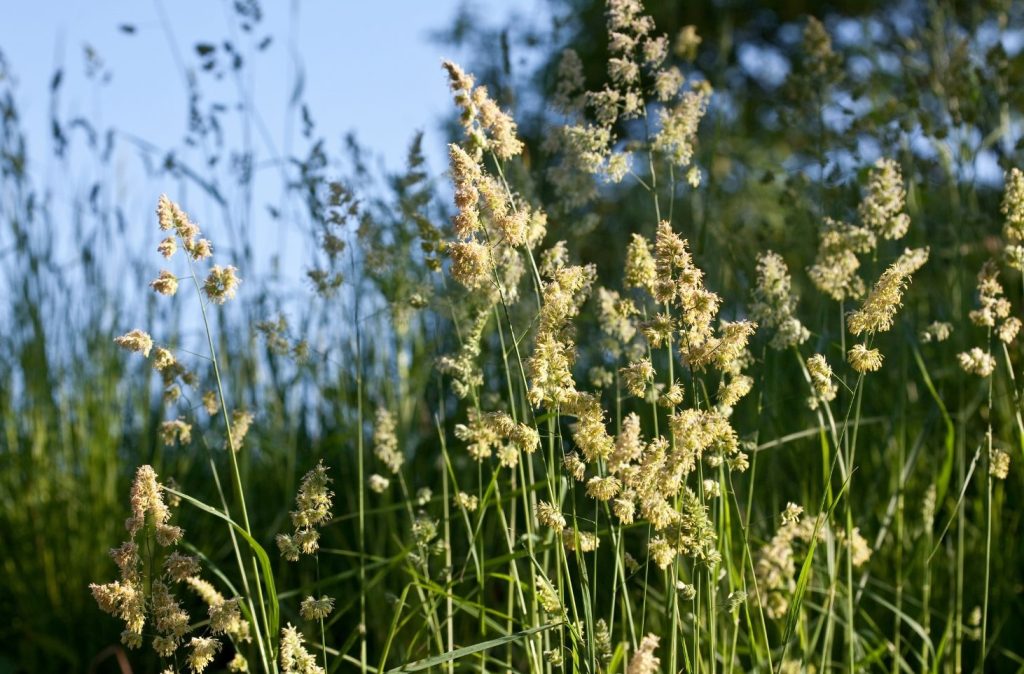If you’ve ever spent a sunny afternoon sneezing your head off or blinking through itchy eyes, you’re not alone. Millions of people deal with seasonal allergies in the UK every year, and hayfever is easily one of the most common culprits. But what causes hayfever, exactly? That’s where things get interesting.
While most people pin it on springtime pollen, the full picture involves a mix of hayfever triggers — from your environment to your family history and even the food you eat. Different types of pollen hit at different times of the year, and for some people, that sneaky fruit salad could be part of the problem, too.
This guide breaks down the main types of pollen allergy, the impact of air quality, and the science behind tree vs grass pollen, including how hayfever and food allergies can be more connected than you might think.
Grass Pollen

Grass pollen is, without doubt, the UK’s most common hayfever trigger. If your symptoms flare up between late May and July, there’s a good chance this is the one giving you trouble. Around 90% of people with seasonal allergies react to grass pollen, so if it feels like you’re not alone in sneezing your way through summer, that’s because you’re really not.
This type of pollen allergy usually peaks in early summer, especially on warm, dry days when the air feels thick and heavy. And while you can’t see pollen floating around, your nose, eyes and throat will often be the first to let you know it’s there.
Because grass pollen season can overlap with other types — especially trees and weeds — knowing the difference between tree vs grass pollen can help you track patterns and better manage your symptoms.
Tree Pollen
Tree pollen tends to strike earlier in the year, often catching people off guard just as winter ends. If you find yourself dealing with hayfever triggers in March, April or early May, tree pollen could be the cause. It’s especially common among people with seasonal allergies in the UK, where certain trees are more likely to release large amounts of pollen during spring.
Some of the main culprits include:
- Birch
- Oak
- Alder
- Hazel
Birch is particularly notorious, as its pollen is highly allergenic and often overlaps with food-related reactions, too.
Understanding the differences between tree vs grass pollen isn’t just academic — it can help you plan ahead, track symptoms more accurately, and speak more confidently about what might actually be affecting you.
Weed Pollen
Just when you think hayfever season is winding down, weed pollen shows up to keep it going into autumn. For some people, this late arrival is one of the most frustrating hayfever triggers because it extends symptoms well beyond summer.
In the UK, plants like nettles, dock and mugwort are common offenders — but ragweed, though more prominent in the US, is becoming a concern in parts of Europe too. These weeds tend to release pollen between August and October, especially on dry, breezy days.
Since pollen allergy symptoms from weeds often overlap with leftover grass or tree reactions, it’s easy to misjudge the source. But knowing about these less obvious culprits can help explain why your seasonal allergies just won’t quit.
Air Pollution and Environmental Irritants

Pollen alone isn’t always to blame — for many people, hayfever triggers go beyond just the plants themselves.
Air pollution, especially in cities, can make things much worse. Tiny particles from car exhausts and industrial fumes, like nitrogen dioxide and PM2.5, don’t just irritate your airways on their own — they can also stick to pollen grains, making them more potent once inhaled.
Research suggests that pollution can even alter the structure of pollen, which might explain why symptoms feel stronger in urban areas than in the countryside. And for people with asthma or other respiratory issues, the combination of pollen allergy and poor air quality can be especially tough to manage.
So if you notice your seasonal allergies flare up more on high-traffic days, this could be why.
Genetics and Family History
If you’ve ever wondered why hayfever seems to run in families, it’s not just a coincidence. Like many allergic conditions, the tendency to react to pollen can be inherited. If one or both of your parents have seasonal allergies, there’s a higher chance you’ll experience them too.
But it’s not purely genetic. Families often share similar environments — same home, same area, same exposure to hayfever triggers like pets, mould or certain pollens. So it’s a mix of what’s in your DNA and what’s in the air around you.
Understanding this connection won’t change your genes, but it can help explain why some people are more prone to pollen allergy than others, even from childhood.
Weather Conditions
The weather has a huge influence on how much pollen ends up in the air and how badly it affects you. Dry, windy days tend to stir things up, sending pollen grains flying and making seasonal allergies feel a whole lot worse. On the flip side, a bit of rain can actually help by washing pollen out of the air, at least temporarily.
That said, right after a summer shower, there can be a spike in pollen release from grass and weeds, so it’s not always clear-cut. Some experts also believe climate change is extending pollen seasons and increasing allergen intensity, which may explain why hayfever seems to be getting worse for some people each year.
Cross-Reactivity with Certain Foods
If you’ve ever noticed your mouth feeling itchy after eating apples or raw carrots — especially during spring or summer — you might be experiencing something called oral allergy syndrome (OAS). It’s a lesser-known side effect of pollen allergy, where your immune system mistakes proteins in certain foods for pollen proteins.
This type of hayfever and food allergy overlap is most common with birch pollen sufferers, who often react to apples, pears, hazelnuts or even celery. The symptoms are usually mild — a tingling mouth or scratchy throat — but they can still be confusing if you’ve never linked the two.
So if your hayfever triggers seem to pop up at the dinner table, it might not be the food itself, but how your immune system connects it to what’s floating in the air.
Explore our allergy treatments or check out our trusted range of hayfever tablets — all available with quick, discreet delivery from WePrescribe.


